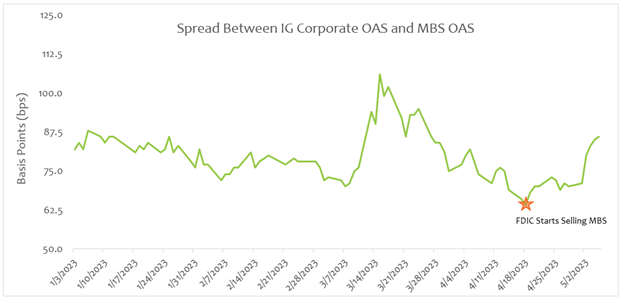Mortgages at the Forefront of Regional Bank Struggles
May 11, 2023

Late last year, I had written about mortgage-backed securities (MBS) and how they came under pressure in 2022 as interest rates rose and interest rate volatility increased. MBS extend when interest rates rise, meaning investors in MBS receive cash flows further out into the future than originally anticipated. The extension-risk inherent in MBS can exacerbate losses on MBS as interest rates increase. Many U.S. commercial banks purchased MBS in 2020/21 as a way to earn net interest margin on the substantial deposit inflows they were experiencing. At that time, banks were paying next to nothing on their deposits, and the cash flows generated by MBS were thought to be an appropriate match for these deposits.
But on March 10 this year, Silicon Valley Bank became the second-largest bank in U.S. history to fail at the time and has since become the third-largest due to the subsequent failure of First Republic Bank. Two days later, Signature Bank failed. The Federal Deposit Insurance Corporation (FDIC) stepped in to seize control of the banks’ combined $114 billion securities (primarily MBS) portfolio. When markets reopened on March 13, interest rates had plummeted and spreads on fixed-income assets had widened.
As today’s Chart of the Week depicts, the reaction in investment-grade (IG) corporate bonds was more severe than in MBS. However, over the next month, spreads on IG corporates recovered while MBS spreads remained under pressure as investors prepared for the FDIC’s sales of its newly acquired MBS portfolio. This trend reversed on April 18, the day the FDIC began selling its MBS portfolio, and the spread between IG corporates and MBS has tightened since.
Despite MBS having no inherent credit risk due to government guarantees, the FDIC is expected to get back roughly 86 cents on the dollar for its securities portfolio versus the 100 cents on the dollar that depositors receive. While that fact may be a bit shocking, what has been more interesting as a fixed-income investor is the relative strength of mortgages since the start of the FDIC’s sales. One good indicator of this strength is the FDIC’s sale of roughly $1 billion non-agency mortgages at levels 20 to 30 basis points tighter than just prior to the sales.
Key Takeaway
MBS reacted poorly to the FDIC’s seizures of Silicon Valley Bank and Signature Bank but have fared better since the FDIC began selling in mid-April. There are several factors that may help explain the relative strength in mortgages since then. First, MBS valuations cheapened during the fallout from March’s bank failures, and the FDIC’s sales may have presented investors — primarily money managers who have been underweight mortgages — with a scalable opportunity to increase their exposure to mortgages. Second, with the end of the Federal Reserve’s interest rate increases widely expected, interest rate volatility has fallen, which is a tailwind for MBS valuations. Lastly, investors’ concerns about a deteriorating economic outlook could drive inflows into this high-quality, government-guaranteed asset class.
This material is for informational use only. The views expressed are those of the author, and do not necessarily reflect the views of Penn Mutual Asset Management. This material is not intended to be relied upon as a forecast, research or investment advice, and it is not a recommendation, offer or solicitation to buy or sell any securities or to adopt any investment strategy.
Opinions and statements of financial market trends that are based on current market conditions constitute judgment of the author and are subject to change without notice. The information and opinions contained in this material are derived from sources deemed to be reliable but should not be assumed to be accurate or complete. Statements that reflect projections or expectations of future financial or economic performance of the markets may be considered forward-looking statements. Actual results may differ significantly. Any forecasts contained in this material are based on various estimates and assumptions, and there can be no assurance that such estimates or assumptions will prove accurate.
Investing involves risk, including possible loss of principal. Past performance is no guarantee of future results. All information referenced in preparation of this material has been obtained from sources believed to be reliable, but accuracy and completeness are not guaranteed. There is no representation or warranty as to the accuracy of the information and Penn Mutual Asset Management shall have no liability for decisions based upon such information.
High-Yield bonds are subject to greater fluctuations in value and risk of loss of income and principal. Investing in higher yielding, lower rated corporate bonds have a greater risk of price fluctuations and loss of principal and income than U.S. Treasury bonds and bills. Government securities offer a higher degree of safety and are guaranteed as to the timely payment of principal and interest if held to maturity.
All trademarks are the property of their respective owners. This material may not be reproduced in whole or in part in any form, or referred to in any other publication, without express written permission.

